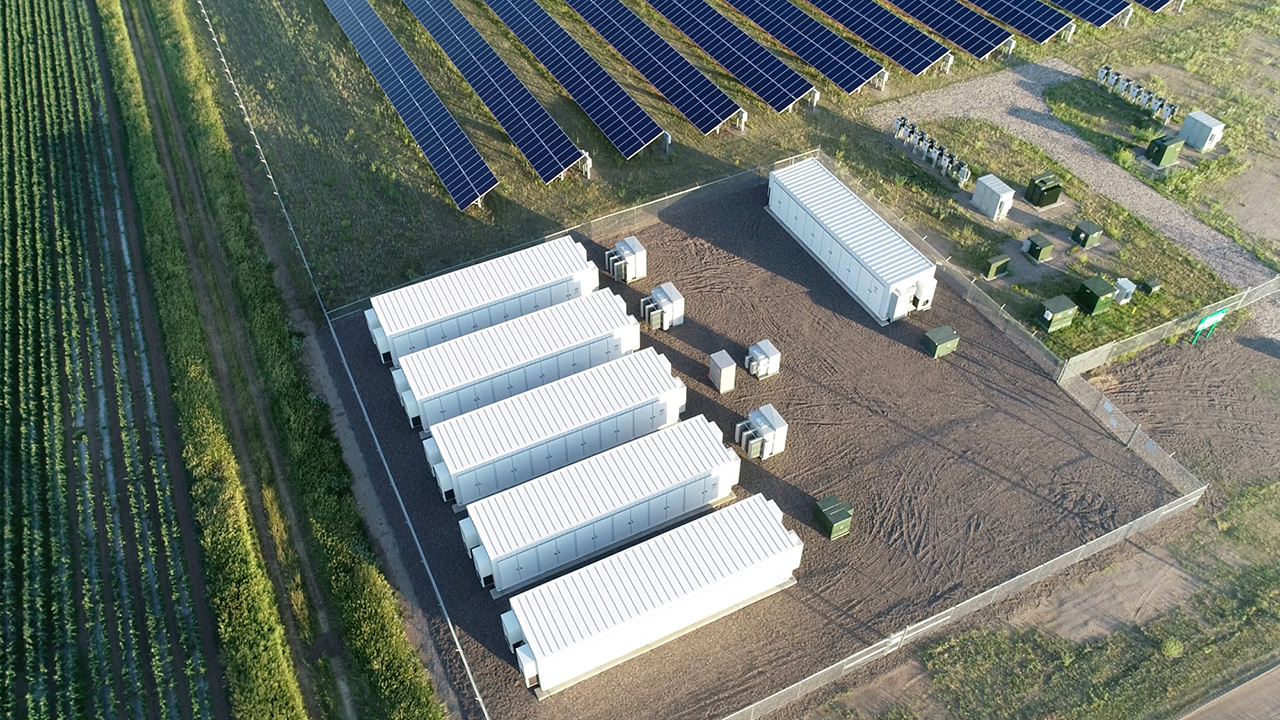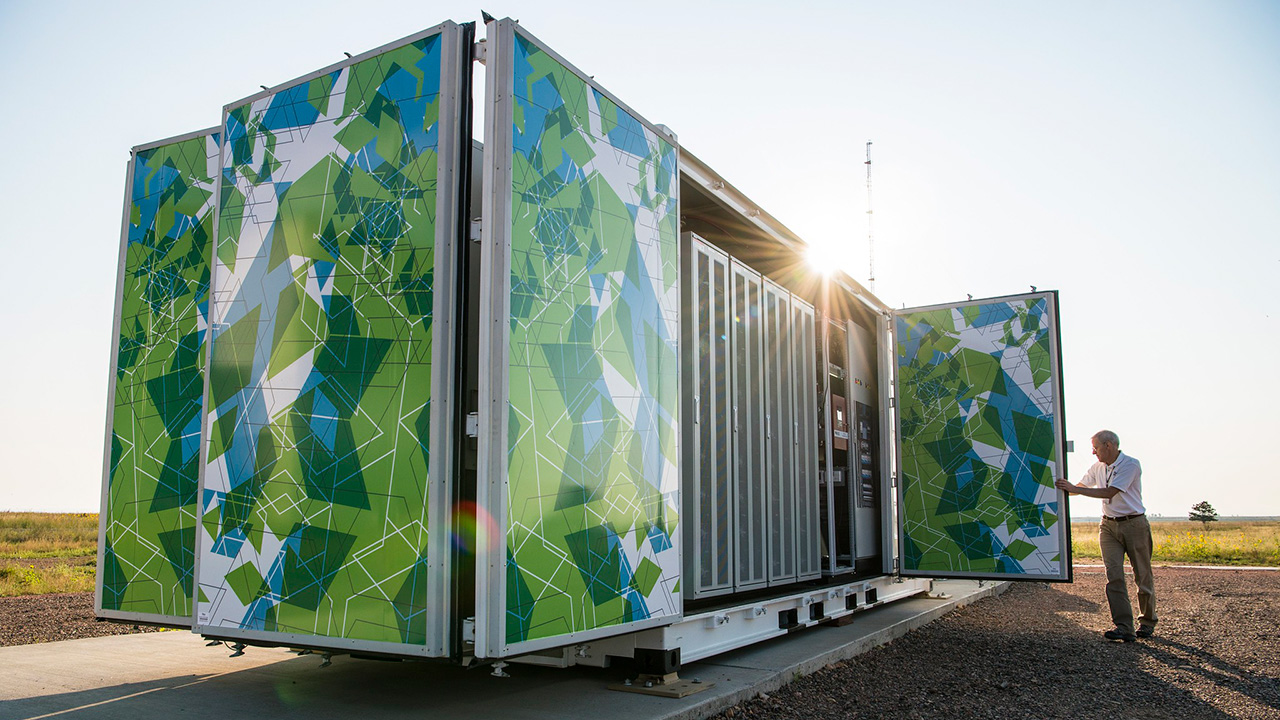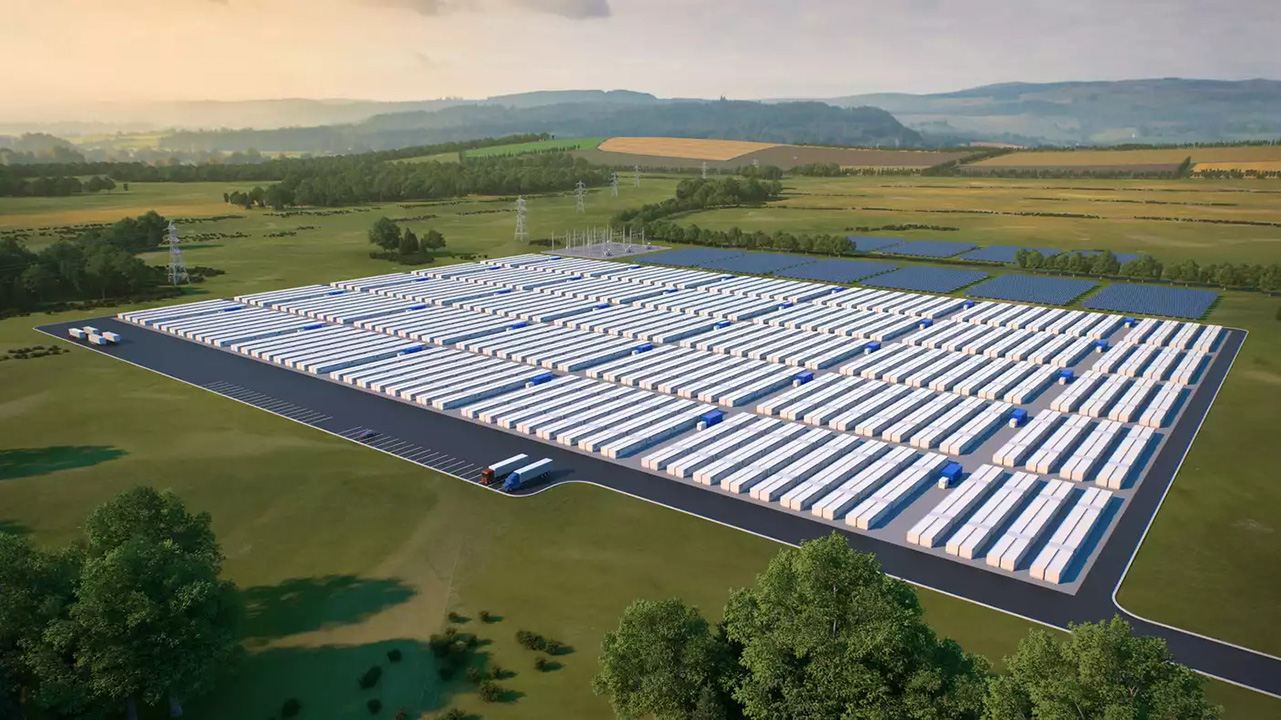
A key technology we need to avoid climate disasters is literally in the palm of your hand, right now, as you read this.
Or at least right in front of you, if you’re reading this on a computer.
Let me explain.
We know that we need to decarbonize all sectors of our economy by mid-century to avoid the worst impacts of climate change. In Minnesota, we’re working to transition our electricity off dirty power sources like coal and natural gas to wind and solar power, which has helped reduce electricity generation emissions by 54% since 2005, a stunning improvement. But we’ve still got a long way to go to fully decarbonize our electric grid, 24/7, by 2050.
Battery storage is a newer, very important piece of the puzzle in building a 100% carbon-free electric grid. Batteries are the most common form of energy storage, acting as a bridge to our future power system—one that’s carbon-free, reliable, and affordable—and yes, it uses the same technology that powers your phone and computer you’re using right now.
In this (admittedly longer) blog post, you’ll learn how energy storage is valuable to our electric grid, where Minnesota is already building energy storage projects, and how Fresh Energy is plugging in to ensure batteries are incorporated to the grid in a smart, long-term way.
After reading this, you’ll have a great understanding of how storage is already an essential part of our clean energy mix. Let’s dive in!
What is battery storage?
Here’s the main idea behind battery storage’s role on a cleaner electric grid: when it’s windy and sunny and there’s a lot of wind or solar on the system, we can use that extra, cheap power to charge up batteries to use later when it’s not as windy or sunny. This not only lets us use more wind and solar power overall, but also increases grid reliability as well, since batteries can provide a reserve of firm (or available at almost all times) power that our electric grid operator, the Midcontinent Independent System Operator, can use in both emergencies and day-to-day operations.
Transitioning our electric grid to carbon-free sources like wind and solar has required us to reimagine our traditional fossil-fuel grid to one that’s cleaner, dynamic enough to incorporate weather-dependent sources of power like wind and solar, and more resilient to increasingly extreme weather. Fresh Energy has long advocated for building more transmission lines to transfer clean energy across vast geographical distances for lower emissions and better reliability. At the same time, we’re advocating for building more batteries to transfer clean energy across time, not just space, so that we can utilize as much affordable, renewable power as possible.
Put simply, energy storage lets us use more renewable energy more often.
Energy storage can work on both the distributed level, like installing small batteries in homes, businesses, and hospitals for increased reliability, and at the utility-scale level, where large batteries are used to store and discharge large amounts of power to benefit the electric grid. This post focuses on the latter: how large, utility-scale energy storage can help us build an equitable energy transition that unlocks reliable, affordable, clean electricity.
Energy wonks have long said that renewables and batteries go together like peanut butter and jelly, cheese and crackers, or—if you’ll permit me to make a Minnesotan twist on this analogy—potlucks and hotdish: together, they make a way better electric system than on their own.
Next, let’s get into the many benefits that battery storage provides to the electric grid.
How batteries are valuable to our electric grid—and its customers
Today, battery storage is known for providing clean electricity more often. But that’s not how batteries got their start on the grid.
The very first utility-scale energy storage facility technically opened back in 1929, but modern storage as we know it today started in 2012 with a lithium-ion battery project in Oregon. Since then, energy storage has grown to 16 gigawatts (GW) as of 2023, which is expected to nearly double by the end of this year. Today, there are about 34.5 GW of battery storage projects in the Midwest electric grid’s (MISO) queue alone.

Why is energy storage growing so quickly in the U.S.? Because it provides a multitude of benefits to the grid—and its customers—including:
- Batteries provide frequency regulation for the electric grid
The first way batteries became a valuable part of our energy mix sounds boring at first—but stick with me! Imagine you’re an operator in charge of the electric grid. Your task is to make sure there’s enough power (but not too much power!) every single second of the day to meet society’s needs, 24/7. That’s a daunting task, because if you aren’t matching electricity supply and demand closely, infrastructure starts to deteriorate and break down, leading to brownouts and even blackouts on the grid. You’d want a resource to help you manage the quick ups and downs of electrical use.
Batteries are uniquely able to charge and discharge power instantaneously, a valuable resource for grid operators charged with balancing the supply of electricity second to second. This is called frequency regulation, a grid ancillary service that utility-scale batteries started providing when they debuted in the early 2010’s.
Grid operators have historically used peaker plants—like natural gas plants—to quickly fire up or reduce power on the grid to meet short-term demand. But natural gas peaker plants have a few major problems: they pollute our air with carbon dioxide and methane, a greenhouse gas that traps 28 times as much heat in our atmosphere as CO2, a major contributor to climate change, and can have acute air pollution impacts on nearby communities.
While batteries got their start by providing frequency regulation to the grid, it wasn’t long for new uses to emerge, too. - Batteries stabilize electricity prices hour by hour to provide cheaper, reliable power
Batteries aren’t just useful to the electric grid by managing frequency second to second, they’re also helpful for smoothing out volatile electricity prices minute by minute and hour by hour.
Electricity follows the law of supply and demand just like all of our other goods and services: it’s expensive when demand is high and supply is low, and it’s cheap when demand is low and supply is high. Prior to batteries, electricity generators had a simple choice: turn your power plant “on” (or “up”) and sell electricity to the grid at its current price, or turn your plant “off” (or “down”) and sell less power. Batteries changed the game: They can store energy when supply is high and electricity is cheap, then sell it later when supply is low and electricity is higher—saving money for both power companies and customers.
By storing cheap electricity to be used later, batteries enable utilities to shave off peak demand and help stabilize and lower electricity prices hour to hour, which in turn helps to reduce overall prices for electricity. That means batteries aren’t only helpful to electric grid operators, but also to power plant owners that can provide cheaper energy more profitably, as well as customers like me and you who can now access cheaper electricity more often. - Batteries and renewables go together like potlucks and hotdish
It wasn’t long for power plant owners to recognize another use for batteries: storing renewable power for later use. Wind and solar provide extremely cost-effective electricity, and batteries allow us to use more renewable power more often.
Some folks like to oversimplify renewable energy’s challenges, like pointing out that the wind isn’t always blowing or the sun isn’t always shining. But this generalization fails to capture many nuances of our electric system, including the benefits of regional transmission for moving power around and the ways batteries have revolutionized how we can use renewable power more reliably and affordably.
Wind and solar farms have been co-locating batteries with their projects to store lots of cheap energy from the wind or sun to provide power later after sunset or during less-windy times. This is especially true for solar power, which produces the most electricity in the middle of the day when demand is relatively low, then stops producing electricity at sundown when electricity demand is typically the highest.
In the late 2010s, solar developers started building hybrid projects of “solar plus storage,” investing more money up front to harness solar energy and storing it to use later during peak demand. Hybrid projects like wind plus storage and solar plus storage require higher up-front capital expenditures when being built, but because they provide low-cost electricity during peak demand, they can offer cheaper and more reliable power over the project’s lifespan and allow grid operators to use clean electricity during peak demand. That’s a win-win-win for the electric grid, utilities, and customers.
We know that in order to clean up the electricity system, we should invest as much as possible in wind and solar, because they are available today, they are efficient, and they are very affordable. But they’re weather-dependent resources, and sometimes we have too much wind or solar on the system at once. Batteries are a neat solution to that problem by absorbing excess, clean generation to discharge at a later time, turning clean power into firm power.
Right now, most energy storage projects being built are short-duration, lithium-ion battery projects that can discharge for up to four hours at a time. But newer, longer-duration pilot projects are also being built, which can provide power for multiple days at a time—a whole new level of functionality that will help counter extreme weather events that happen more often as a result of climate change.
Battery storage projects in Minnesota
Battery storage is an evolving technology, and Minnesota has a handful of projects online or in development. As of Spring 2024, these are major energy storage projects in Minnesota:

Connexus Energy’s storage projects
Connexus Energy, the largest electric co-op in Minnesota, built Minnesota’s first large-scale solar plus storage projects back in 2018. In total, the two projects add 10 megawatts (MW) of solar and 15 MW of energy storage. The batteries, which look like large white shipping containers laid next to the solar panels, use lithium iron phosphate to store the solar power for later use when electricity demand is at its peak, saving power supply costs and passing those savings along to its members. Pollinator-friendly vegetation was planted beneath the solar panels by a local native prairie landscaping company, providing habitat for insects and birds.
Looking ahead, Connexus is planning to build more solar and storage to take advantage of cheap power and discharge it during higher-demand times of electricity use. The co-op recently broke ground on the state’s first battery storage project sited at a substation instead of a nearby solar array, which is expected to come online in 2024. This is all a part of its 10-year resource plan that goes big on solar and storage: Connexus is planning to add 100 MW of local, grid-scale solar, an additional 180-230 MW of rooftop solar, and 30 MW of four-hour battery storage between now and 2033.
Grand Rapids Public Utilities & Minnesota Power’s Itasca solar plus storage project
Northern Minnesota’s first solar plus storage project came online in 2022 when Grand Rapids Public Utilities combined 2 megawatts of pollinator-friendly solar with a 1-megawatt, 2.5-hour lithium-ion battery. The project was a collaborative effort after being initiated by the Itasca Clean Energy Group: The City of Grand Rapids owns the 15 acres of property; Grand Rapids Public Utilities contracts the benefits of the solar plus storage project; US Solar constructed, maintained, and owns the project; and Minnesota Power developed and operates the battery’s load management model.
Adding the battery storage component to the solar field changed the project’s economics: while solar on its own would have had some payback, adding battery storage to the project ended up reducing rates for customers by allowing the solar panels to charge the batteries and selling the power later in the day during peak demand, reducing Grand Rapids’ wholesale power needs from Minnesota Power.

Xcel Energy’s Sherco solar plus storage project is replacing Minnesota’s largest coal plant
Xcel Energy is currently transitioning its Sherburne County Generating Station (Sherco) coal plant in Becker, Minnesota, into the largest solar project in the upper Midwest with 710 MW of solar and a 10 MW iron-air, long-duration battery developed by Form Energy. The battery will allow Xcel Energy to store renewable energy from the nearby solar and wind, via the proposed Minnesota Energy Connection transmission line, to be used during periods of high demand. Since it can deliver electricity for 100 hours, it can help weather-dependent generation like wind and solar provide low-cost electricity reliably, even during severe winter storms and polar vortexes. It is expected to come online in late 2025 and will allow Xcel Energy to learn how to better integrate storage as it seeks four-hour, 10- to 12-hour, and multi-day batteries in its future energy mix.
Great River Energy’s iron-air battery
Great River Energy (GRE), which supplies power to many of Minnesota’s electric co-ops across 60% of Minnesota’s geography, is building Minnesota’s first iron-air battery. It is expected to come online shortly before Xcel’s iron-air battery before the end of 2025. The 1.5 MW battery will be charged from power available on the electric grid and is capable of discharging power continuously for 100 hours in Cambridge. Long-term storage technology like GRE’s Cambridge battery is an important tool in the toolbox to get from a 90 percent decarbonized power grid to 100 percent carbon-free electricity by 2040.
What’s next?
Fresh Energy advocates for decarbonizing the electricity sector in Minnesota’s legislative and regulatory venues, like working to pass climate-smart laws with the Minnesota Legislature and engaging in dockets and providing testimony with the Minnesota Public Utilities Commission.
In the 2023 legislative session, Minnesota lawmakers considered legislation to build 3,000 MW of energy storage in the state by 2034. While lawmakers did not pass the legislation, they did direct the Minnesota Department of Commerce to conduct a study to evaluate the potential of energy storage in Minnesota, which Fresh Energy is reviewing.
The Minnesota Legislature also established two energy storage grant/incentive programs in 2023 to co-locate energy storage with solar systems across the state. The two programs anticipate launching this year, and Fresh Energy is gearing up to engage in their stakeholder processes to ensure the program effectively captures energy storage’s benefits to our electric grid as we transition to a carbon-free electric grid.
At the Minnesota Public Utilities Commission, we frequently advocate for more battery storage adoption alongside clean power in utility resource plans. We’re currently engaging with Otter Tail Power’s Integrated Resource Plan, and shortly afterward Xcel Energy’s and Minnesota Power’s resource plans will be up—and we’ll be advocating that all these plans go big on battery storage and renewables while minimizing fossil fuel generation. We’re also working to advance storage at the distribution level, too, to ensure utilities are forecasting storage well in their Integrated Distribution Plans, as batteries can help balance the electricity generated from home solar power to benefit the grid more efficiently.
Battery storage has been an important, emerging issue in our advocacy with MISO (Midcontinent Independent System Operator), the Midwest’s regional electric grid operator. Fresh Energy works alongside other environmental-sector organizations to ensure that wholesale power markets value the services that battery storage provides. When planning transmission and market design requirements, we’re advocating MISO adequately forecast and take advantage of the capabilities of battery technologies that are coming online.
While battery technology is quickly evolving, many use critical minerals, and Fresh Energy supports undertaking an evidence- and data-driven assessment on a project-by-project basis of the consequences, impacts, and attributes of a mining proposal, acknowledging there must be a careful consideration of how resource extraction will impact our environment and communities across space and time at the local, state, regional, national, and global level.
You can stay updated with the latest battery storage news, along with Fresh Energy’s other important clean energy and climate advocacy work, by signing up for our Powering Progress newsletter. Stay tuned for future explainers on different energy storage technologies, from batteries to pumped hydro to hot rocks!
Go Deeper:
- Check out this post from Distilled that explains how utility-scale battery storage has evolved in the U.S.
- The Volts podcast has hosted five helpful podcast episodes about lithium-ion batteries, including why they’re important, their competitors, and the future of battery technology
- Read how technology like transmission lines and the electricity distribution system can help unlock more clean power on the Midwest’s electrical grid

